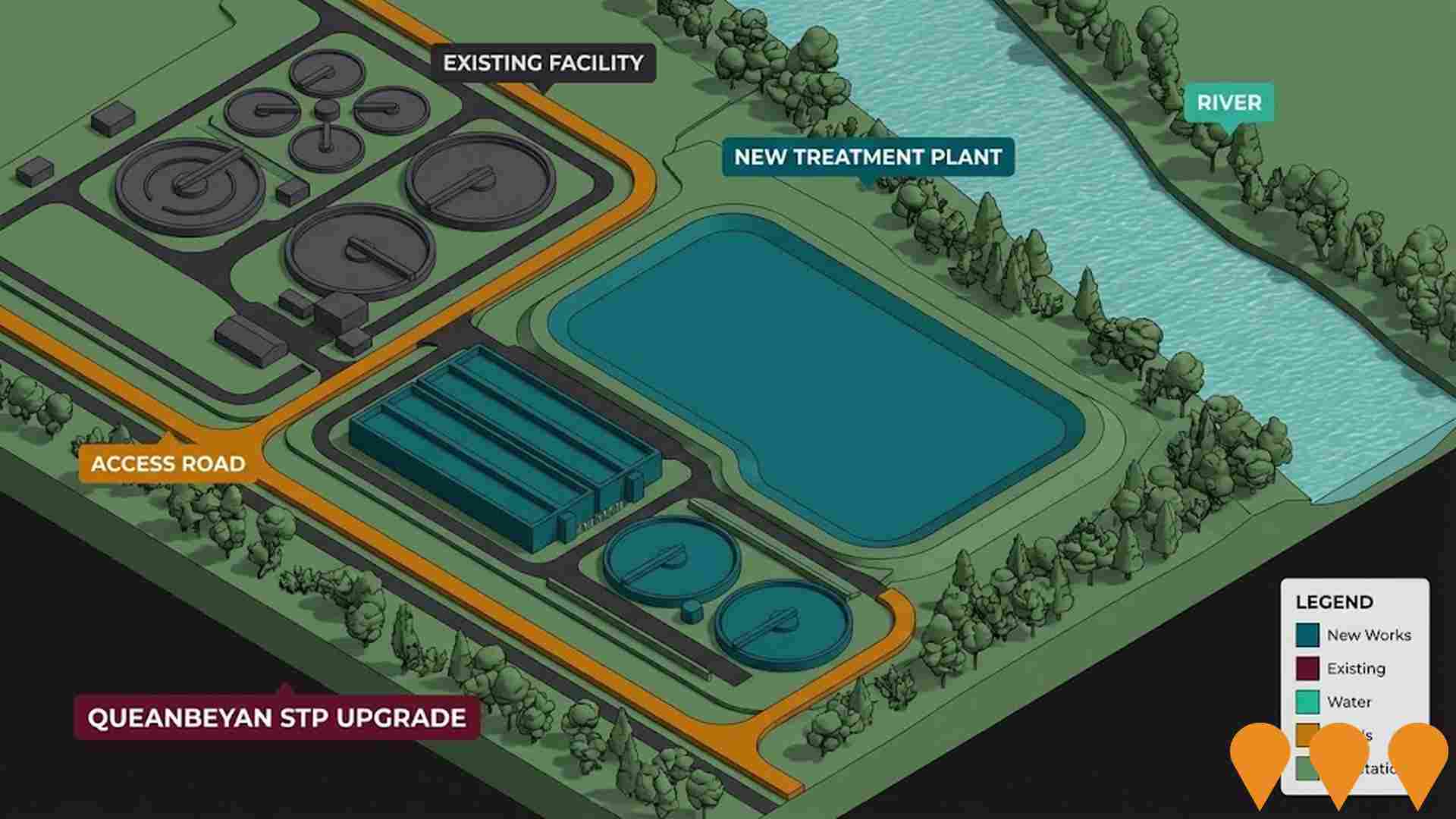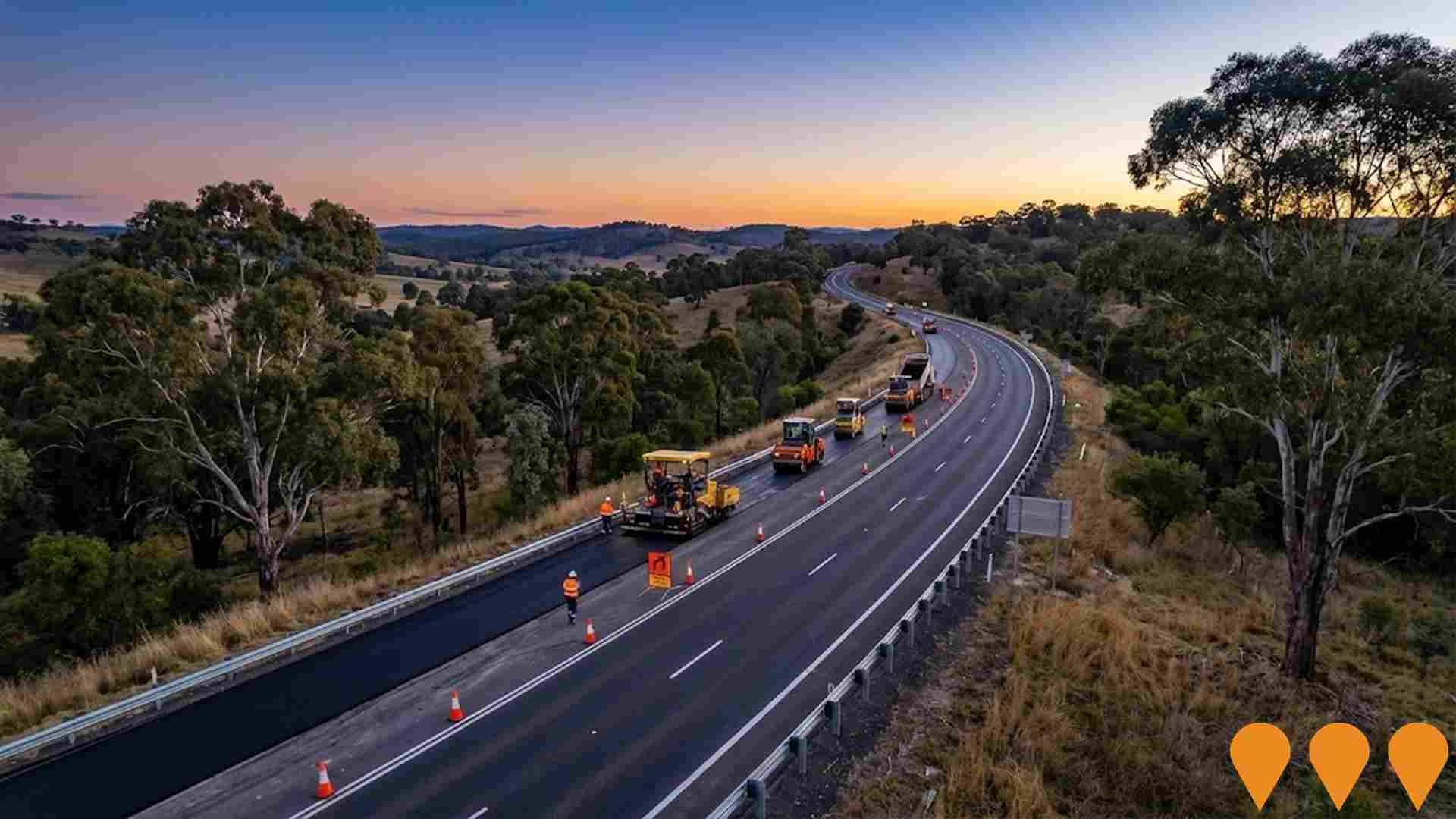Chart Color Schemes
est. as @ -- *
ABS ERP | -- people | --
2021 Census | -- people
Sales Activity
Curious about local property values? Filter the chart to assess the volume and appreciation (including resales) trends and regional comparisons, or scroll to the map below view this information at an individual property level.
Find a Recent Sale
Sales Detail
Population
Karabar has shown very soft population growth performance across periods assessed by AreaSearch
Karabar's population was approximately 8,456 as of November 2025. This figure represents a decrease of 61 individuals since the 2021 Census, which reported a population of 8,517 people. The change is inferred from the estimated resident population of 8,446 in June 2024 and an additional 33 validated new addresses since the Census date. This results in a population density ratio of 1,211 persons per square kilometer, higher than the average across national locations assessed by AreaSearch. Natural growth contributed approximately 58.4% of overall population gains during recent periods.
AreaSearch adopts ABS/Geoscience Australia projections for each SA2 area, released in 2024 with a base year of 2022. For areas not covered, AreaSearch uses NSW State Government's SA2 level projections, released in 2022 with a base year of 2021. Growth rates by age group are applied to all areas for years 2032 to 2041. By 2041, the population is projected to decline by 508 persons. However, specific age cohorts like those aged 85 and over are expected to grow, with a projected increase of 107 people in this group.
Frequently Asked Questions - Population
Development
The level of residential development activity in Karabar is very low in comparison to the average area assessed nationally by AreaSearch
Karabar has seen approximately four new homes approved annually over the past five financial years, with a total of 21 approvals between FY-2021 and FY-2025. No new homes have been approved in FY-2026 so far. The average value for new homes being built is $326,000.
This year has seen $19.7 million worth of commercial approvals, indicating ongoing investment activity. Compared to the rest of NSW, Karabar shows significantly reduced construction levels, at 94.0% below the regional average per person. The limited new supply generally supports stronger demand and higher values for established dwellings, which is also under the national average, suggesting an established market with potential planning limitations. Recent development has been entirely detached houses, maintaining Karabar's traditional suburban character focused on family homes. Developers are building more traditional houses than the current mix suggests, indicating strong demand for family homes.
The location has approximately 2117 people per dwelling approval, demonstrating an established market. With population expected to remain stable or decline, Karabar should see reduced pressure on housing, potentially creating opportunities for buyers.
Frequently Asked Questions - Development
Infrastructure
Karabar has moderate levels of nearby infrastructure activity, ranking in the top 50% nationally
Local infrastructure changes significantly impact an area's performance. AreaSearch identified five projects potentially affecting this region. Notable projects are: Queanbeyan Sewage Treatment Plant Upgrade (scheduled for completion in 2023), Yass Road and Bungendore Road intersection upgrade (commencing June 2022), Ellerton Drive intersection upgrade (starting September 2022), and the Queanbeyan Regional Integrated Transport Plan (expected to commence in late 2022).
Professional plan users can use the search below to filter and access additional projects.
INFRASTRUCTURE SEARCH
 Denotes AI-based impression for illustrative purposes only, not to be taken as definitive under any circumstances. Please follow links and conduct other investigations from the project's source for actual imagery. Developers and project owners wishing us to use original imagery please Contact Us and we will do so.
Denotes AI-based impression for illustrative purposes only, not to be taken as definitive under any circumstances. Please follow links and conduct other investigations from the project's source for actual imagery. Developers and project owners wishing us to use original imagery please Contact Us and we will do so.
Frequently Asked Questions - Infrastructure
Queanbeyan Sewage Treatment Plant Upgrade
The project involves replacing the existing sewage treatment plant, which is nearing the end of its service life and is currently overloaded, with a new modern facility. The upgrade will increase the treatment capacity to service 75,000 equivalent people (EP), with the potential for future expansion to 112,500 EP. The new plant will feature an advanced treatment process including biological nutrient removal, tertiary filtration, and UV disinfection, which will improve the quality of treated effluent discharged into the Molonglo River. A development application for the project was lodged with the ACT Government on December 7, 2023.
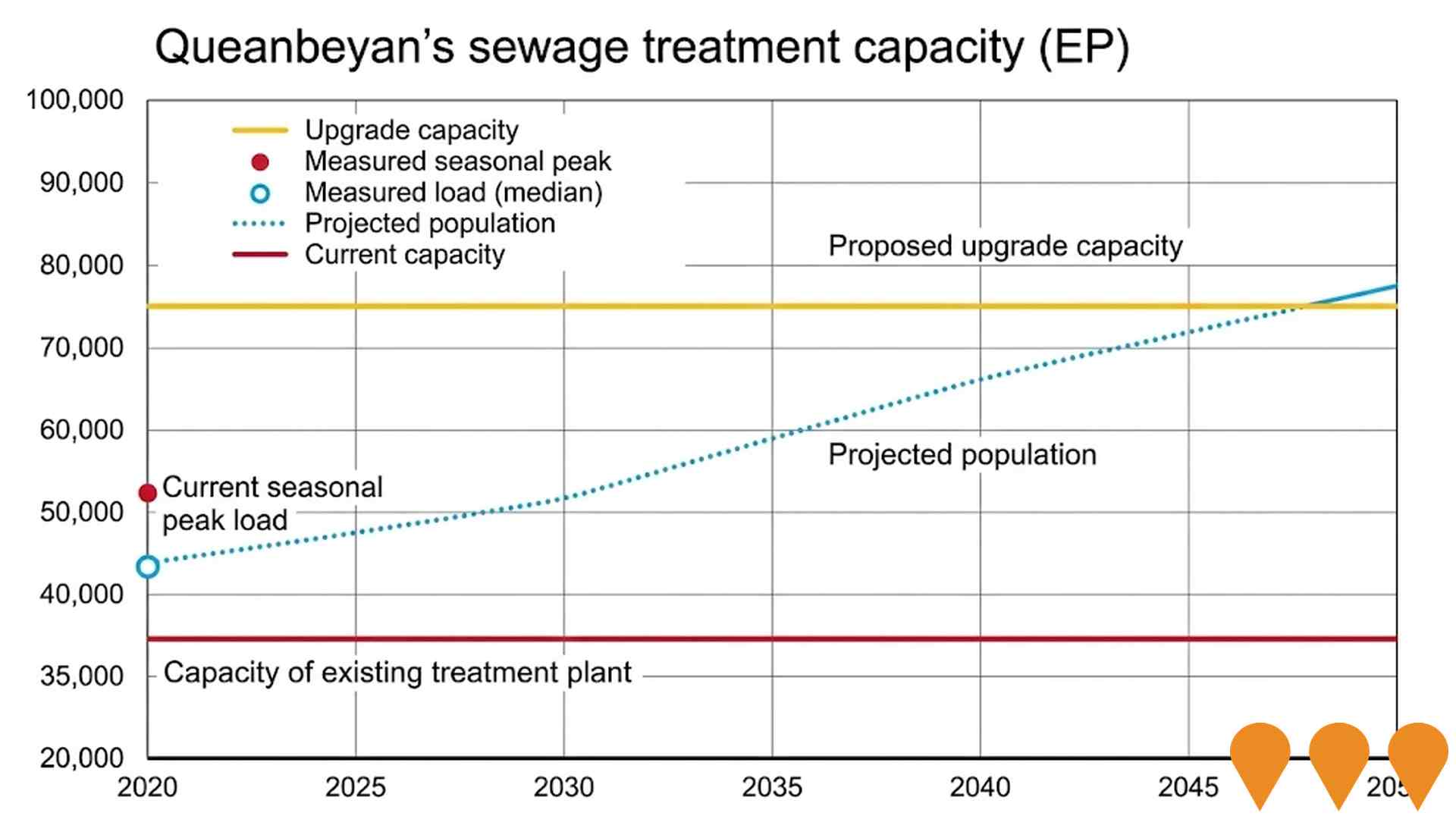
Googong Township
Large-scale masterplanned township development on the NSW/ACT border (Queanbeyan-Palerang LGA), 16 km south-east of Canberra. Joint venture between Mirvac and Peet. When complete (c.2038) will deliver 6,200 dwellings for approx. 18,000 residents across five neighbourhoods. As of mid-2025 the township has over 9,000 residents and more than 3,200 homes occupied. Features a fully integrated water recycling system (IWC), 5-Star Green Star Communities rating, town centre with Coles and specialty retail, two primary schools (Anglican School Googong and The Anglican School Googong Early Learning Centre), community centre, sports facilities, 280 ha of open space and extensive walking/cycling trails.
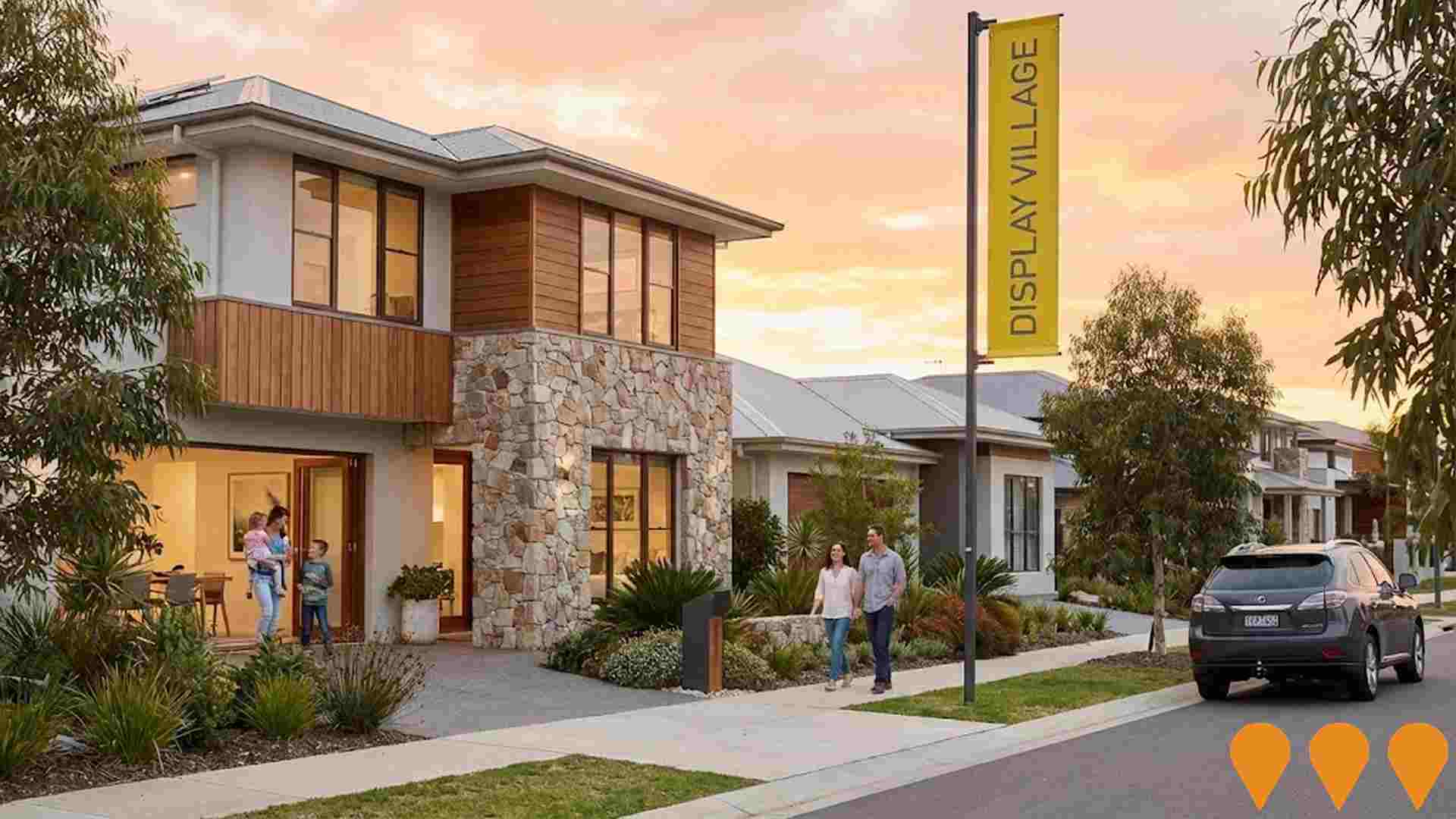
South Jerrabomberra Urban Release Area
A master-planned urban development featuring approximately 1500 residential dwellings, business parks, industrial estates, innovation precincts, regional sports complex, intermodal transport hub, new high school, and community amenities including parks, sports facilities, and retail spaces to create a sustainable community on the NSW-ACT border.
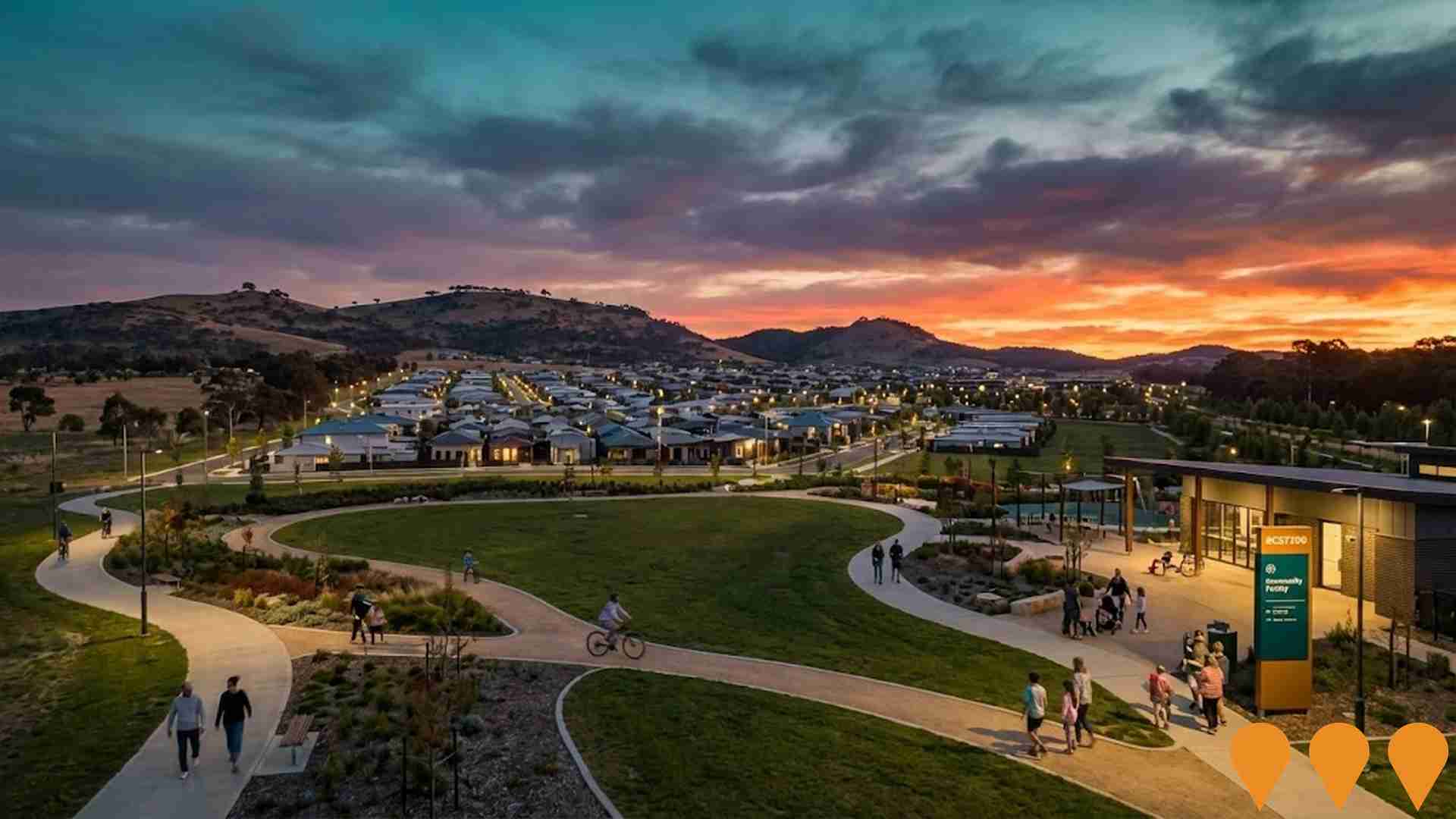
Enhanced bus and light rail corridors (Belconnen & Queanbeyan to Central Canberra)
ACT is progressing an integrated program to enhance high-frequency bus and future light rail corridors that link Belconnen and Queanbeyan with central Canberra. Light Rail Stage 2A (City to Commonwealth Park) commenced construction in early 2025 with services targeted from 2028, while planning and approvals continue for Stage 2B to Woden. The ACT Government has acknowledged and is planning upgrades for the Belconnen-to-City bus corridor as groundwork for a future east-west light rail Stage 3, and is coordinating cross-border public transport initiatives with NSW through the Queanbeyan Region Integrated Transport Plan and the ACT-NSW MoU for Regional Collaboration.
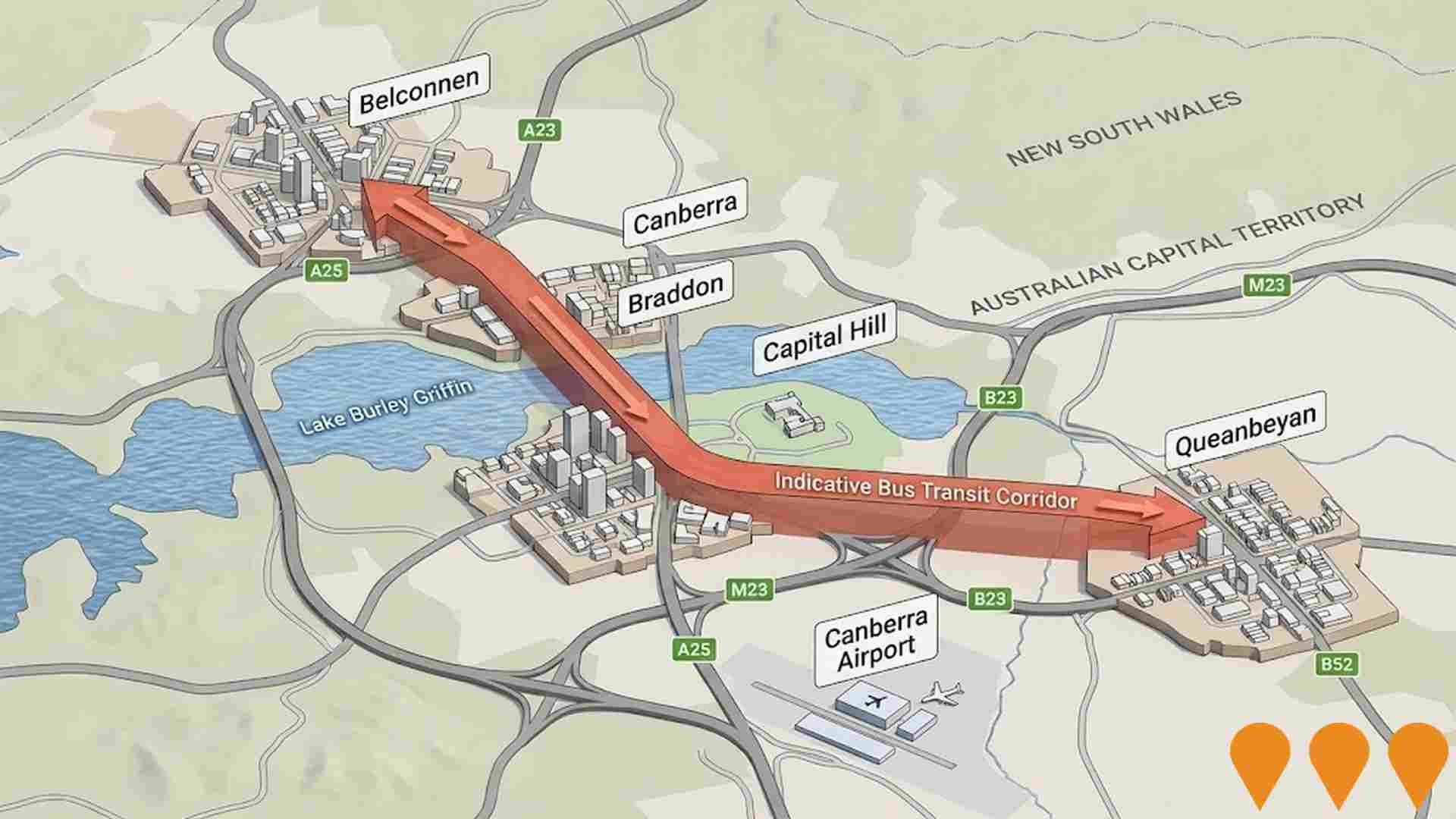
HumeLink
HumeLink is a new 500kV transmission line project connecting Wagga Wagga, Bannaby, and Maragle, spanning approximately 365 km. It includes new or upgraded infrastructure at four locations and aims to enhance the reliability and sustainability of the national electricity grid by increasing the integration of renewable energy sources such as wind and solar.
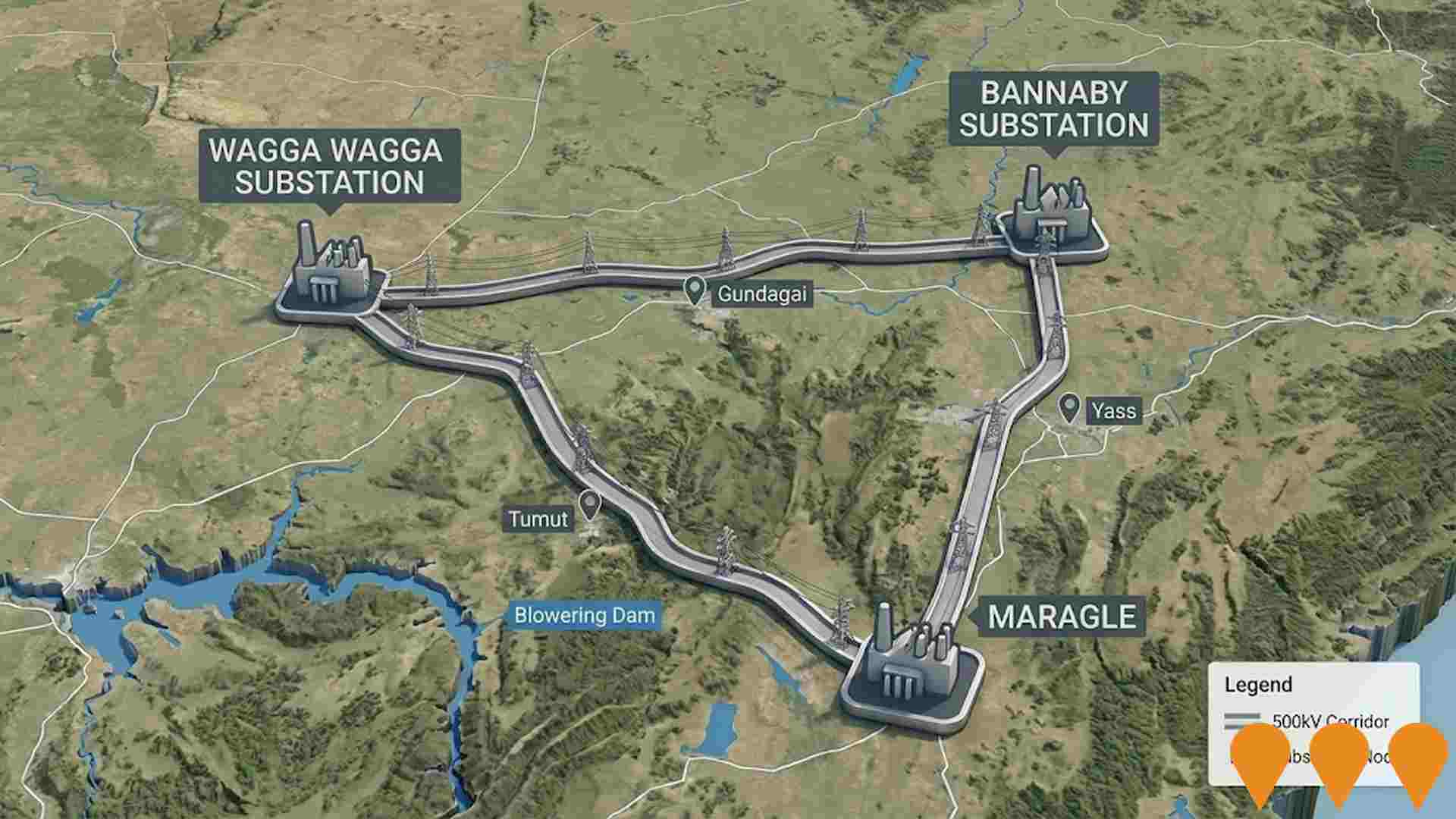
Queanbeyan Regional Integrated Transport Plan
Comprehensive transport planning initiative with 64 key actions for next 10 years. Addresses road safety, active transport connectivity, public transport availability, and future transport needs. Improved connections between Queanbeyan and ACT.
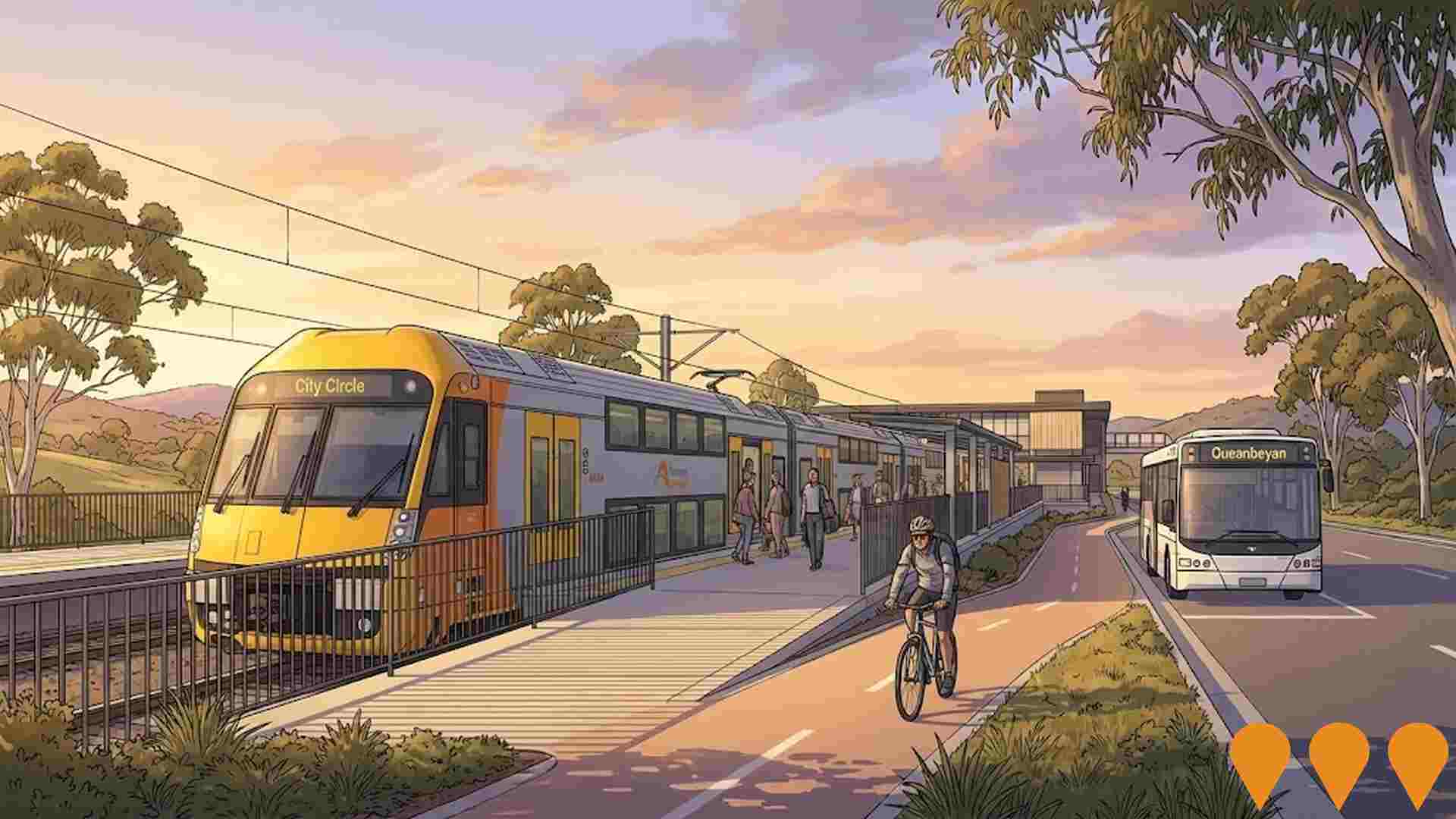
Big Canberra Battery (Williamsdale BESS)
A 250 MW / 500 MWh battery energy storage system at Williamsdale in southern Canberra, delivered by Eku Energy as Stream 1 of the ACT Government's Big Canberra Battery. Construction commenced in November 2024 with partners CPP and Tesla supplying Megapack systems. The asset will connect to Evoenergy's 132 kV network near the Williamsdale substation to provide two hours of dispatchable power, grid services and reliability for the ACT. Target operations in 2026.
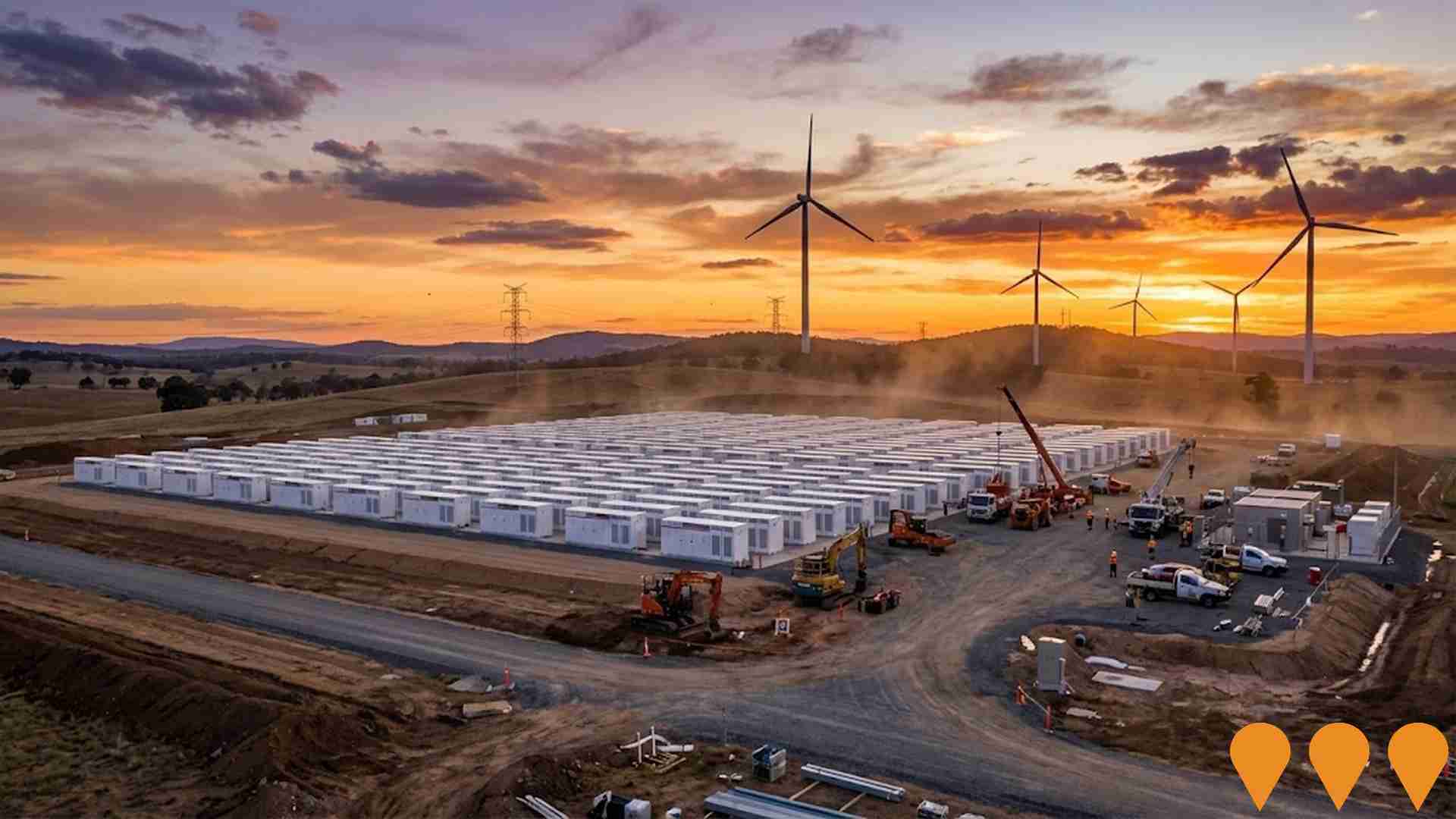
Queanbeyan to Bungendore Bulk Water Supply Pipeline
Major water infrastructure project to improve water security and supply reliability between Queanbeyan and Bungendore. Council progressing to tender-ready status.

Employment
Despite maintaining a low unemployment rate of 3.4%, Karabar has experienced recent job losses, resulting in a below average employment performance ranking when compared nationally
Karabar has a skilled workforce with an unemployment rate of 3.4% as of June 2025. In this month, 4671 residents were employed while the unemployment rate was 0.3% lower than Rest of NSW's rate of 3.7%.
Workforce participation in Karabar was high at 65.4%, compared to Rest of NSW's 56.4%. The leading employment industries among residents were public administration & safety, construction, and health care & social assistance. Karabar had a particular specialization in public administration & safety, with an employment share 3.1 times the regional level. However, health care & social assistance was under-represented, with only 10.3% of Karabar's workforce compared to Rest of NSW's 16.9%.
Over the 12 months to June 2025, labour force levels decreased by 3.6% in Karabar, and employment decreased by 4.8%, leading to a rise in unemployment rate by 1.2 percentage points. In contrast, Rest of NSW saw employment contract by 0.1%, the labour force grow by 0.3%, and unemployment rise by 0.4 percentage points. Jobs and Skills Australia's national employment forecasts from May 2025 suggest that national employment is expected to expand by 6.6% over five years and 13.7% over ten years. Applying these projections to Karabar's employment mix indicates potential local growth of approximately 6.1% over five years and 12.6% over ten years, though these are simple extrapolations for illustrative purposes and do not account for localised population projections.
Frequently Asked Questions - Employment
Income
The area exhibits notably strong income performance, ranking higher than 70% of areas assessed nationally through AreaSearch analysis
Karabar's median taxpayer income was $56,730 and average income was $66,789 in financial year 2022, according to postcode level ATO data aggregated by AreaSearch. This is slightly above national averages of $49,459 (median) and $62,998 (average) for Rest of NSW. Based on Wage Price Index growth of 12.61% since financial year 2022, estimated median income in Karabar as of September 2025 is approximately $63,884, with average income estimated at $75,211. Census data indicates household, family and personal incomes in Karabar are around the 70th percentile nationally. Income distribution shows that 33.6% (2,841 individuals) fall within the $1,500 - 2,999 earnings band, similar to broader trends across the area at 29.9%. After housing expenses, 85.6% of income remains for other expenses. Karabar's SEIFA income ranking places it in the 5th decile.
Frequently Asked Questions - Income
Housing
Karabar is characterized by a predominantly suburban housing profile, with above-average rates of outright home ownership
Karabar's housing structure, as per the latest Census, consisted of 80.4% houses and 19.6% other dwellings (semi-detached, apartments, 'other' dwellings). In comparison, Non-Metro NSW had 74.5% houses and 25.5% other dwellings. Home ownership in Karabar was at 29.8%, aligning with Non-Metro NSW's level. Mortgaged dwellings made up 41.0%, while rented dwellings were 29.2%. The median monthly mortgage repayment was $1,950, below the Non-Metro NSW average of $2,167. Median weekly rent in Karabar was $350, slightly lower than Non-Metro NSW's $355. Nationally, Karabar's mortgage repayments were higher at $1,950 compared to Australia's average of $1,863, while rents were lower at $350 versus the national figure of $375.
Frequently Asked Questions - Housing
Household Composition
Karabar has a typical household mix, with a fairly typical median household size
Family households account for 73.2% of all households, including 33.0% couples with children, 24.6% couples without children, and 14.2% single parent families. Non-family households constitute the remaining 26.8%, with lone person households at 24.6% and group households making up 2.2%. The median household size is 2.6 people, aligning with the average for the Rest of NSW.
Frequently Asked Questions - Households
Local Schools & Education
Educational outcomes in Karabar fall within the lower quartile nationally, indicating opportunities for improvement in qualification attainment
The area has university qualification rates of 20.2%, significantly lower than the NSW average of 32.2%. This presents both a challenge and an opportunity for targeted educational initiatives. Bachelor degrees are most common at 12.4%, followed by postgraduate qualifications (5.4%) and graduate diplomas (2.4%). Trade and technical skills are prominent, with 37.0% of residents aged 15+ holding vocational credentials - advanced diplomas (10.7%) and certificates (26.3%).
Educational participation is high at 29.0%, including 10.4% in primary education, 8.0% in secondary education, and 4.1% pursuing tertiary education. Karabar's 3 schools have a combined enrollment of 1,236 students, with typical Australian school conditions (ICSEA: 977) offering balanced educational opportunities. The area has an educational mix including 1 primary, 1 secondary, and 1 K-12 school. School capacity exceeds residential needs at 14.6 places per 100 residents compared to the regional average of 10.1, indicating it serves as an educational center for the broader region.
Frequently Asked Questions - Education
Schools Detail
Nearby Services & Amenities
Transport
Transport servicing is moderate compared to other areas nationally based on assessment of service frequency, route connectivity and accessibility
Transport analysis shows 43 active transport stops in Karabar, consisting of buses. These stops are served by 42 routes, offering 607 weekly passenger trips. Transport accessibility is rated excellent, with residents typically located 149 meters from the nearest stop.
Service frequency averages 86 trips per day across all routes, equating to approximately 14 weekly trips per individual stop.
Frequently Asked Questions - Transport
Transport Stops Detail
Health
Health performance in Karabar is lower than average with common health conditions somewhat prevalent across both younger and older age cohorts
Karabar faces significant health challenges, with common health conditions prevalent across both younger and older age cohorts. The rate of private health cover in Karabar is approximately 52%, covering about 4,430 people, compared to 61.0% across Rest of NSW.
Mental health issues and arthritis are the most common medical conditions in the area, impacting 9.5% and 9.2% of residents respectively. About 65.3% of Karabar's residents declared themselves completely clear of medical ailments, compared to 68.7% across Rest of NSW. In Karabar, 15.6% of residents are aged 65 and over (1,317 people), which is higher than the 13.4% in Rest of NSW. Health outcomes among seniors present some challenges, broadly in line with the general population's health profile.
Frequently Asked Questions - Health
Cultural Diversity
The level of cultural diversity witnessed in Karabar was found to be above average when compared nationally for a number of language and cultural background related metrics
Karabar exhibited above-average cultural diversity, with 18.5% of its residents born overseas and 15.4% speaking a language other than English at home. Christianity was the predominant religion in Karabar, comprising 57.0%, compared to 52.1% across Rest of NSW. The top three ancestry groups were Australian (27.7%), English (23.6%), and Irish (7.7%).
Notably, Macedonian ethnicity was overrepresented at 3.2% in Karabar versus the regional average of 1.5%, Serbian at 0.9% compared to 0.6%, and Croatian at 1.2% versus 0.9%.
Frequently Asked Questions - Diversity
Age
Karabar's population is slightly younger than the national pattern
Karabar has a median age of 38, which is lower than the Rest of NSW figure at 43 but matches the national norm also at 38 years old. The age group of 25-34 years shows strong representation in Karabar at 16.2%, compared to the Rest of NSW figure. However, the 65-74 age cohort is less prevalent in Karabar at 8.7%. According to the Census conducted on 2021 August 10, the age group of 35 to 44 years has grown from 13.3% to 14.8% of the population between the censuses of 2016 and 2021. The 25-34 age cohort also increased during this period, from 14.9% to 16.2%. Conversely, the 45-54 age group has declined from 13.5% to 12.2%, and the 5-14 age group dropped from 12.8% to 11.5%. Demographic projections suggest Karabar's age profile will undergo significant changes by 2041. Leading this demographic shift, the 85+ age group is projected to grow by 64%, adding 92 people to reach a total of 235 from the previous figure of 142. The aging population trend is evident, with those aged 65 and above comprising 54% of the projected population growth. Meanwhile, the 65-74 and 45-54 age cohorts are expected to experience population declines.
